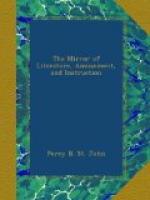THE MIRROR OF LITERATURE, AMUSEMENT, AND INSTRUCTION.
Vol. 12, No. 342.] Saturday, November 22, 1828. [Price 2d.
* * * * *
[Illustration: Council office, &c. Whitehall. ]
Council office, &c. Whitehall.
From the Druids’ Temple, at Abury, (our last engraving,) to the Council Office, at Whitehall, is a long stride in the march of time. From “grave to gay, and lively to severe,” is nothing to it; but variety is the public dictum; and with more sincerity than the courtier in Tom Thumb, we say to the public,
“Whate’er your majesty shall
please to name,
Long cut or short cut, to us’ tis
all the same.”
On the annexed page is represented the new splendid range of buildings, including the Council Office, Board of Trade, &c. at Whitehall. The architect, Mr. Soane, has adapted the facade from the Temple of Jupiter Stator, at Rome.[1]
But Mr. Soane’s adaptation has been only partial, and he has adhered merely to the details of the columns and entablature. “The facade,” it is well observed in an early Number of the Athenaeum, “enjoys one of the most favourable sites for the display of a public building which the metropolis affords; no limit has been set to the expense; the finest materials the country yields have been used in its construction; the richest example of the richest order which antiquity has left us, has been lavishly employed in its decoration; and yet,” continues the critic, “is not the whole a failure?” He then describes the effect of it as “poor, or at best but pretty,” and attributes the absence of grandeur to the “want of sufficient elevation.”—“To the general elevation it may be objected, that it has no prominent centre; that, composed of two wings and an intermediate space receding, it has more the character of a flank than a front building; and that the want of a central entrance derogates greatly from its dignity as a principal facade.”
But we are mere amateurs in these matters, and it will be as well to leave the remainder of this criticism to the more studious reader. We have, however, glanced at the principal defects which the writer in the Athenaeum points out, and we are bound to admit the justice of his remarks. The details which produce this effect would not be so generally interesting. “The order itself,” says he, “it must be admitted, is well copied, and excellently executed;” but Mr. Soane’s application of it is loudly censured—a Roman temple being inappropriate for a British Council Office. Perhaps our critic would have preferred a facade like that of the Palais de Justice at Paris,—a platform, ascended by an immense flight of steps, which serves as a basement for a projecting body of four Doric columns; with four large pedestals in front, and statues of Strength, Plenty, Justice, and Prudence, as the cardinal virtues of English legislation and trade.




